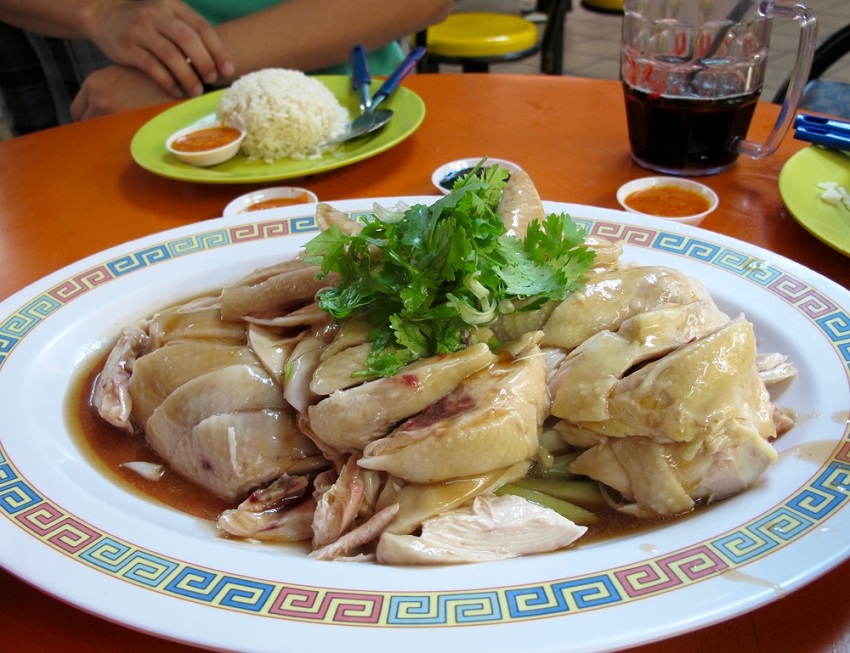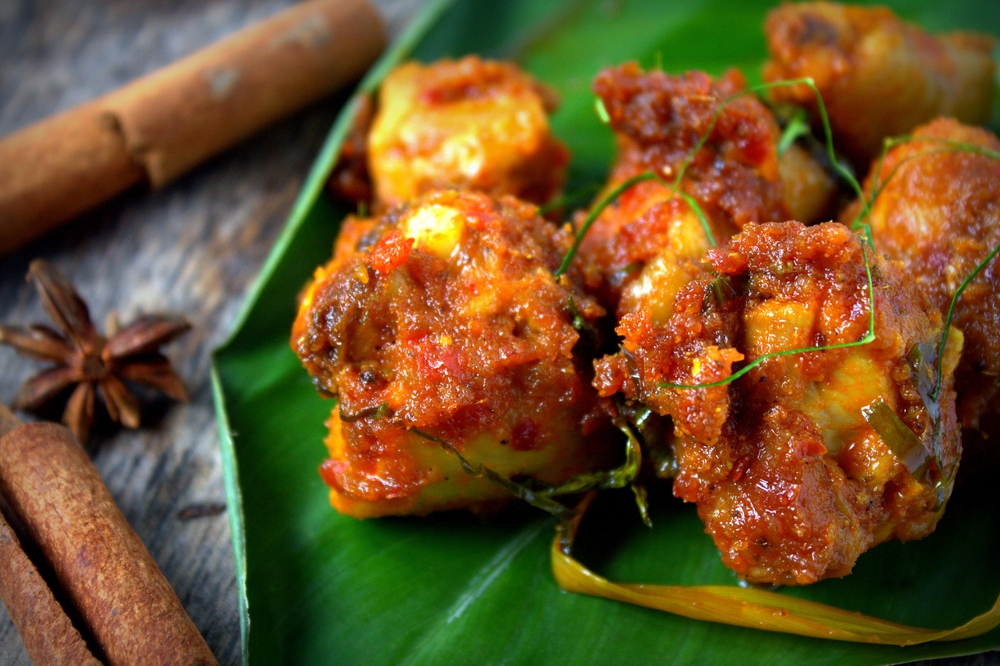Singapore - food
‘Food’ is one of the four essential factors in human life. However, food is more than just a factor contributing to human existence. A diverse society nurturing different ethnic groups of people, both natives and immigrants, allows them to forge their own identities.
One distinctive sense of their identities is food culture. There has been a scholarly attempt in defining ‘food culture’ as various kinds of food on earth that human consume, but each has its own uniqueness. For each country, the processes are different regarding cooking such as burning, boiling, stir-frying, frying, steaming, stewing and baking. The cooking traditions are also variedly different. (นงลักษณ์ หงษ์คา, 2557, หน้า 7) Prayad Saiwichian’s attempt to define the term of food culture as customs, methods and traditions revolving around the food in which a community or a society continues to strictly follow every step of practices. Raw materials have been defined and refined as nobody would eat them raw. Knowledge of food is never an instinct but rather a hands-on experience gained from customs, practices and traditions of a family or a society. (ประหยัด สายวิเชียร, 2547, หน้า 65) Moreover, food culture offers a solid reflection on personality, knowledge, ways of life and beliefs of each nation. (ประหยัด สายวิเชียร, 2547, หน้า 112-114)
Singaporean food culture illustrates a diversity of the ethnic groups like Chinese, Malay and Indian including other races immigrating to Singapore. The Indians and Malays have been living here for generations. They introduced spicy spices as essential part of the Singaporean food while many groups of Chinese offer delicate cooking styles. (วิทย์ บัณฑิตกุล, 2555, หน้า 156)
Food vendors on streets or public spaces have been a common sight in Singapore before it claimed the independence. This reflects the social and economic dynamics being driven by the immigrants and laborers from around the world. They hope for a new life in this port city of Malay Peninsula. Before the 20th century, the laborers travelled to Singapore independently without their families. Most of them were unskilled laborers, so they did not have time to cook. Their residents did not have enough space for cooking. It was more convenient to buy cheaper food from the food vendors on streets. When Singaporean economics started expanding after it had declared the independence in 1965, the food vendors on streets were booming as well.
Singapore has a reputation for its cleanliness. The food vendors have been systematized since the 1950’s when industrial factories in Singapore were blooming. The government removed the food vendors to work in factories while building up a food center called ‘Hawker Center’ to support the increasing numbers of the new food vendors. Those food vendors on streets were removed to sell in the food center, business districts and residential areas. The food vendors in Singapore considerably changed.
The food vendors on streets have been part of Singapore for a long time. It is a piece of history reflecting its social orders and economic developments on this small island. Now Singapore is trying to forge its own identity and uniqueness on grounds of cultural diversity. And food is one of the agendas. (นันทนา ปรมานุศิษฏ์, 2556, หน้า 128-132)
Singaporean food can be categorized according to the ethnic groups.
- Chinese Food
Chinese food is the most influential because the Chinese is the dominant group in Singapore. They are Hokkien, Teochew, Hakka and Hainanese. Hokkien food found in Singapore is Hokkien stir-fried noodles while Teochew food are stir-fried crabs and steamed fish. Guangdong foods are Dim Sum and porridge. Hakka food is Yong Dau Foo and Hainanese food is chicken rice. Bak Kut Teh is cooked in Teochew, Guangdong and Hokkien styles but the Teochew style is the most popular. Its soup is clear yet hot as peppers and garlics are added in. (นันทนา ปรมานุศิษฏ์, 2556, หน้า 63-64)
1.1 Singaporean Chicken Rice
Hainanese Chicken Rice has become Singapore’s national food called Singaporean Chicken Rice. Chicken Rice is following the Chinese everywhere across the world such as Malaysia and Vietnam. Even in Thailand, we eat Chicken Rice and are convinced it is Thai food.
There is not much different in cooking Chicken Rice except the sauce. Hainanese Chicken Rice and Singaporean Chicken Rice are served with 2 kinds of sauces, the ginger sauce and chilli sauce. Sweetened soy sauce is another one being served with the Chicken Rice.
The original Hainanese Chicken Rice prefers using Wen-Chang chickens from Wen Chang city. Wen-Chang chickens are small in size. It provides more muscles but less fat. Its texture is soft while giving thin layers of skin. The chicken has a 400-year history since the Qing Dynasty. The breed was taken from Guangdong to Wen Chang where the chickens ate the Sai fruits and evolved to be Wen Chang chickens. The origin of Chicken Rice can be traced back to Wen Chang city on Hainan Island. (นันทนา ปรมานุศิษฏ์, 2556, หน้า 265-266)
1.2 Bak Kut Teh
Bak Kut Teh is Hokkien language meaning meat, bones and tea or herbal drink. Pork ribs are boiled in herbal and spice soup including cinnamons, cloves, white peppers, wolfberries and star anises. It is served with cooked rice and soy sauce with sliced chilli. Teochew Bak Kut Teh is a bit different. The soup is not as thick as the Hokkien’s and spices added into the soup are only garlics and peppers making the soup clearer. (วิทย์ บัณฑิตกุล, 2555, หน้า 160)
1.3 Char Kway Teow
Char Kway Teow is typical stir-fried noodles and a must-try Singaporean food. It had been a dish for the poor. However, when the poor grew wealthier, they made some changes in the recipes by adding more ingredients. Char Kway Teow is cooked from thin rice flour noodles stir-fried with fried garlics, shrimps, Chinese sausages, squids and eggs. Add Chinese cabbages, fish sauce, sweetened soy sauce and chilli Sambol. To make it more tantalizing, add seafood stock. (วิทย์ บัณฑิตกุล, 2555, หน้า 160)
1.4 Chilli Crab
Chilli crab is another famous Singaporean food. It is cooked from Sri Lanka crabs while the sauce is a mixture of tomato sauce, chili sauce, soy sauce, sugar, vinegar, salt, sesame oil. Chili crab’s paste is cooked with garlics, shallots and ground gingers. Stir-fry the crab and put on a lid to cover the pan before leaving it for a while. When the crab turns red, fetch it in a dish. Then use the same pan to cook the paste. Add stock, leave it to boil and melt corn flour. Put the crab into the pan again and stir-fry it until it is mingled. Stir the eggs in it and the dish is ready to serve. The Chili crab is salty, sweet, sour and hot. It has all the flavors. Its thick soup might go well with fried Chinese buns or cooked rice.
Apart from Chilli crab, another famous dish is Black pepper crab. (นันทนา ปรมานุศิษฏ์, 2556, หน้า 257-258)
1.5 Yong Tau Foo
Yong Dou Fu is originally Hakka food. In Mandarin, it is known as Niang Dou Fu meaning stuffed tofu. Hokkien stuffed tofu is featured in many dishes and the one that is more familiar to us is Hokkien noodles served with fish mixed with ground pork stuffed in tofu.
Yong Dou Fu is also a name of stuffed tofu. Tofu varieties include soy bean tofu and triangle-shaped fried tofu stuffed with a mixture of ground fish and pork. Ground spotted mackerel just like fish balls but not mixing with ground pork or anything else is preferred as the cooked stuffing in Singapore. It is not only stuffed in tofu but also in vegetables such as gourds, sweet peppers, spur peppers, okras and eggplants. Stuffed tofu and stuffed vegetables are steamed and later fried. The eating is various as well. Some prefer it being served with bean paste while some with soup. Some even prefer adding noodles. Besides stuffed tofu and stuffed vegetables, some other ingredients are fish balls, fish lines, shrimp balls, crab sticks, tofu sheets and fish or chicken stock. All are served in hot soup and bean paste. The bean paste is made with bean paste, garlics, shallots, sliced gingers, chili sauce and lemonade. Another sauce is the red sauce that is served with stuffed tofu or stuffed vegetables. The red sauce is made from tomato sauce, chili sauce, garlics, lemonade, sugar, salt and corn flour. Corn flour is the one that makes the soup thicker.
The Young Tau Foo ingredients are quite many as well as the vegetables served with it such as Morning glories, cabbages and Chinese cabbages. Though it is usually eaten with clear soup, sometimes it is cooked as Laksa.
Yong Tau Foo is a popular dish in Singapore and Malaysia as Malaysia has listed ‘Yong Tau Foo’ one of the 100 Malaysian heritage cuisines. (นันทนา ปรมานุศิษฏ์, 2556, หน้า 251-253)
1.6 Laksa Lemak
Laksa is a Baba-cultural dish. The Baba is known as the Peranakans whose culture represents is developed from the Hokkiens, the Malays of Malay Peninsula and of Strait of Malacca and the Indonesians on Java Island. Laksa is popular among the people in the South of Thailand, Penang, Malay Peninsula, Singapore and Indonesia. It is locally different as well.
Laksa Lemak is one of the most popular Singaporean Laksa. It is sometimes called ‘Laksa Nyonya’ resembling noodles with coconut milk soup.
The soup of Singaporean Laksa is cooked from shrimps, both fresh shrimps and dried shrimps. Other ingredients are seafood such as shrimps, squids, fish balls, fish lines, tofu, hard-boiled eggs and sometimes chickens, the vegetables such as sliced cucumbers, bean sprouts and scallions. The most important ingredient is Vietnamese corianders providing a unique smell of Laksa. It is even called the Laksa vegetables.
Laksa Lemak noodles are made from rice flour just like Hainanese noodles. The dish can also feature Hokkien noodles or vermicelli instead.
Penang people call it Asam Laksa resembling a sour soup with tamarind which is different from Singaporean Laksa. (นันทนา ปรมานุศิษฏ์, 2556, pp. 247-249)
2. Indian food
Indian and Malay food is influential. Dishes such as soups, Murtabak, Acar, Tandoori, Otak-Otak, Satay, Nasi Goreng and Nasi Lemak added with spices are evidences. (นันทนา ปรมานุศิษฏ์, 2556, หน้า 64)
2.1 Otak-Otak
Otak-Otak is a cuisine of the Malay ethnic group in Singapore, Malaysia and Indonesia. It is similar to steamed fish with curry paste. The mixed ingredients in a banana leaf or a coconut leaf is either grilled or steamed. Otak-Otak is locally different but mainly the same.
Otak-Otak is usually cooked from fish such as tuna, king mackerels and barracuda but shrimps, crabs and squids are preferable. Ground fish is mixed with paste.
When the mixed paste is ready, wrap it in a square-shaped banana leaf or coconut leaf. Then, grill it. The Malays take Otak-Otak as a snack or a light meal served with bread or cooked rice topped with peanut paste. It is very popular.
Another kind of Otak-Otak is wrapped in a bag-shaped banana leaf or is put in a banana leaf container. It is steamed Otak-Otak resembling the Southern Thailand’s Otak-Otak with Daun Kaduk, a kind of vegetables, on the under. The Daun Kaduk makes the smell more tantalizing. The fish is not ground fish but sliced into pieces. It is very popular among the Peranakans and is called ‘Otak-Otak Nyonya’. (นันทนา ปรมานุศิษฏ์, 2556, หน้า 275-276)
2.2 Fish Head Soup
This menu is reflecting how Singapore is known as ‘the port city’. The fish head is a salmon’s head being steamed before it is stir-fired with pastes made from spices such as coriander seeds, cumin seeds, turmeric and black peppers. Add coconut milk in it and let it simmer. The fish head soup is heavily sour because its ingredients include tamarind juice, Lady’s Finger and tomatoes. You may add salt and sugar as well. (วิทย์ บัณฑิตกุล, 2555, หน้า 161)
2.3 Roti Prata
It was introduced to Singapore and Singaporean people have it very meal with coconut milk soup, chicken or fish curry soup. Thai people know it as ‘Roti with dipping soup’. Matabak is another kind of Roti stuffed with shred chicken and spices. It is served with a sauce called ‘Dal’.
3. Malay Food
3.1 Beef Rendang
Rendang has been widely voted as ‘the most delicious food in the world’ as well as Thai Chicken Massaman Curry on the website CNNgo.com in 2011.
It is believed that the food has originally belonged to a minority group, Baso Minang. They are Muslim living on the West of Sumatra Island. Later the Rendang started spreading all over Indonesia, Malaysia, Singapore, Brunei, the Philippines and the South of Thailand. The Baso Minang immigrated to Malacca and introduced this kind of food to this land.
Rendang is similar to Thai Panaeng Curry. The Rendang paste includes dried chili, shallots, garlics, gingers, galangals, lemongrass, coriander seeds, fennels and nutmeg. (นันทนา ปรมานุศิษฏ์, 2556, หน้า 223)
3.2 Satay
This popular food is Tamil-language rooted and was introduced to Singapore through Malaysia. Satay is made of sliced beef that fits in pieces kept in spices such as coriander seeds and fennels. Then, skewer it piece by piece before light-grilling it. It is served with a paste-like sauce resembling the Massaman soup and Acar sauce made from vinegar, sliced cucumbers and sliced shallots.
4. Dishes of other ethnic groups
Besides Chinese, Indian and Malay food, there are some other dishes in Singapore as well.
4.1 Mie Goreng, the island dish
Mie Goreng is stir-fried noodles. It is a single Indonesian main course being popular among the Malays and the Singaporeans. The original Mie Goreng is an adaptation of Chinese stir-fried noodles called ‘Cao Mian’ cooked by the Chinese immigrating of Indonesia. However, they used the Indonesian ingredients instead. As a result, it has become so deliciously popular that it is now an instant-noodle product even in Thailand.
Mie Goreng prefers using thick-cut noodles like the Hokkien noodles stir-fried with chickens, shrimps or beef. However, pork is not preferable because the Indonesians are Muslim. Add vegetables like sliced cabbages and bean sprouts with Sambal paste and sweetened soy sauce. Mie Goreng is cooked differently according to that island’s favor. Sri Raja Chili Sauce or instant Sambal paste can be used instead of Sambal paste. The instant Sambal paste is cooked with the fried-rice, Nasi Goreng. If one wants to try and cook the paste, it is not that complicated. Red chili, shallots, garlics and a little bit of shrimp paste are pestled and mixed together except that the Indonesian recipe would add the candlenuts. Cashews can be used instead or you may add nothing at all. (นันทนา ปรมานุศิษฏ์, 2556, p. 213)
4.2 Sayur Lodeh (Java vegetable soup)
Sayur Lodeh is a vegetable soup with coconut milk. It is typical just like other Indonesian dishes being popular in Malaysia, Singapore and Brunei. It is much celebrated in the Hari Raya Festival or the Eid Day of the Islamic people. The Eid Day takes place twice a year, the Idulfitri Day and Idil Adha Day. The Hari Raya is a joyous festival when the Muslims visit their parents, relatives and neighbors and forgive each other for what they have done. It is the most celebrated day as the Muslims around the world perform their rituals.
The vegetables in the soup include young jackfruits, chayote, eggplants, yardlong beans, bitter beans, cabbages, chili, melinjo, tofu and tempeh or fermented soy beans. The tempeh is a food preservation in which the tempeh is wrapped in a square-shaped banana leaf. It is considered fairly healthy with unique Indonesian ingredients. When being cooked, it is usually cut into dice.
Lodeh is normally served with Lontong, cooked rice wrapped in a cylinder-shaped banana leaf. It is boiled and served with Ketupat or cooked rice wrapped in a delicate rattan-ball shaped coconut leaf which is a symbol of Hari Raya Festival. The Islamic people give this Ketupat to each other. While Ketupat in the South of Thailand is wrapped in a triangle shape, its rice is cooked with coconut milk, sugar, salt and black beans. It is boiled and served with Islamic soups such as Rendang, Lodeh and Satay. This kind of dish is not to be missed in the joyous festival. (นันทนา ปรมานุศิษฏ์, 2556, หน้า 227-229)
4.3 Rojak or Fruits with sweetened shrimp paste
Rojak in Malay language or Rujak in Indonesian language is a spicy salad dish. Its dressing is locally different. How Asian people have fruits is always strange in the eye of the foreigners as we eat fruits with chili powder and salt, with sweetened fish sauce or with sweetened shrimp paste.
The foreigners speculated that we eat fruits with salty paste because the climate here is hot. The loss of minerals occurs all the time, so we need some to replace.
Rojak is popular and locally different. However, it is basically spicy salad made from fruits and vegetables topped with sweetened shrimp paste and roasted peanuts. The most preferable fruits are rose apples, unripen mangoes, guavas, apples, pineapples, yam-beans, cucumbers, torch gingers, scalded bean sprouts, scalded morning glory and fried tofu. In some local areas, batter-fried prawns, dried squids, Chinese donuts, fried meat balls and hard-boiled eggs are added.
The sticky Rojak sauce is made of simmered brown sugar, ripe tamarind, shrimp paste and sometimes sweetened soy sauce. Add chili and pestle it. The flavor is sweet, spicy and salty. Penang’s Rojak prefers using honey.
Rojak is a dish for Mitoni ritual that the Java people adopted from Hinduism in India. If a woman is in her 7th month of her first pregnancy, the ritual is held with a belief it is a blessing for the baby and its family. The pregnant woman and her spouse wear a piece of Batik cloth covering the breasts and sit there while seven seniors in their family bathe them. This ritual is Siraman. The water comes from the seven holy wells and a bowl used to fetch water has scented flowers such as rose, jasmine, White Champaka and Canaga on it. The prediction of the baby gender is part the ritual as well. Either looking at a coconut featured in the ritual or observing the Rojak flavor can pronounce the prediction. If the woman prefers the sweet flavor, the baby is a girl. If she likes the spicy flavor, the baby is a boy. (นันทนา ปรมานุศิษฏ์, 2556, หน้า 261-262)
Bibliography
นงลักษณ์ หงษ์คำ. (2557). วัฒนธรรมอาหารในงานประเพณีของชาวไทลื้อ. เชียงใหม่: มหาวิทยาลัยเชียงใหม่.
นันทนา ปรมานุศิษฏ์. (2556). โอชาอาเซียน. กรุงเทพฯ: มติชน.
ประหยัด สายวิเชียร. (2547). อาหาร วัฒนธรรมและสุขภาพ. เชียงใหม่: นพบุรีการพิมพ์.
วันวิสาข์ รัฐกิจวิจารณ์ ณ นคร. (2556). การศึกษาผลกระทบของการท่องเที่ยวที่มีต่อวัฒนธรรมอาหารท้องถิ่น กรณีศึกษา : เขตเทศบาลปาย ตำบลเวียงใต้ อำเภอปาย จังหวัดแม่ฮ่องสอน. กรุงเทพฯ: มหาวิทยาลัยศิลปากร.
วิทย์ บัณฑิตกุล. (2555). สาธารณรัฐสิงคโปร์. กรุงเทพฯ: สถาพรบุ๊คส์.





